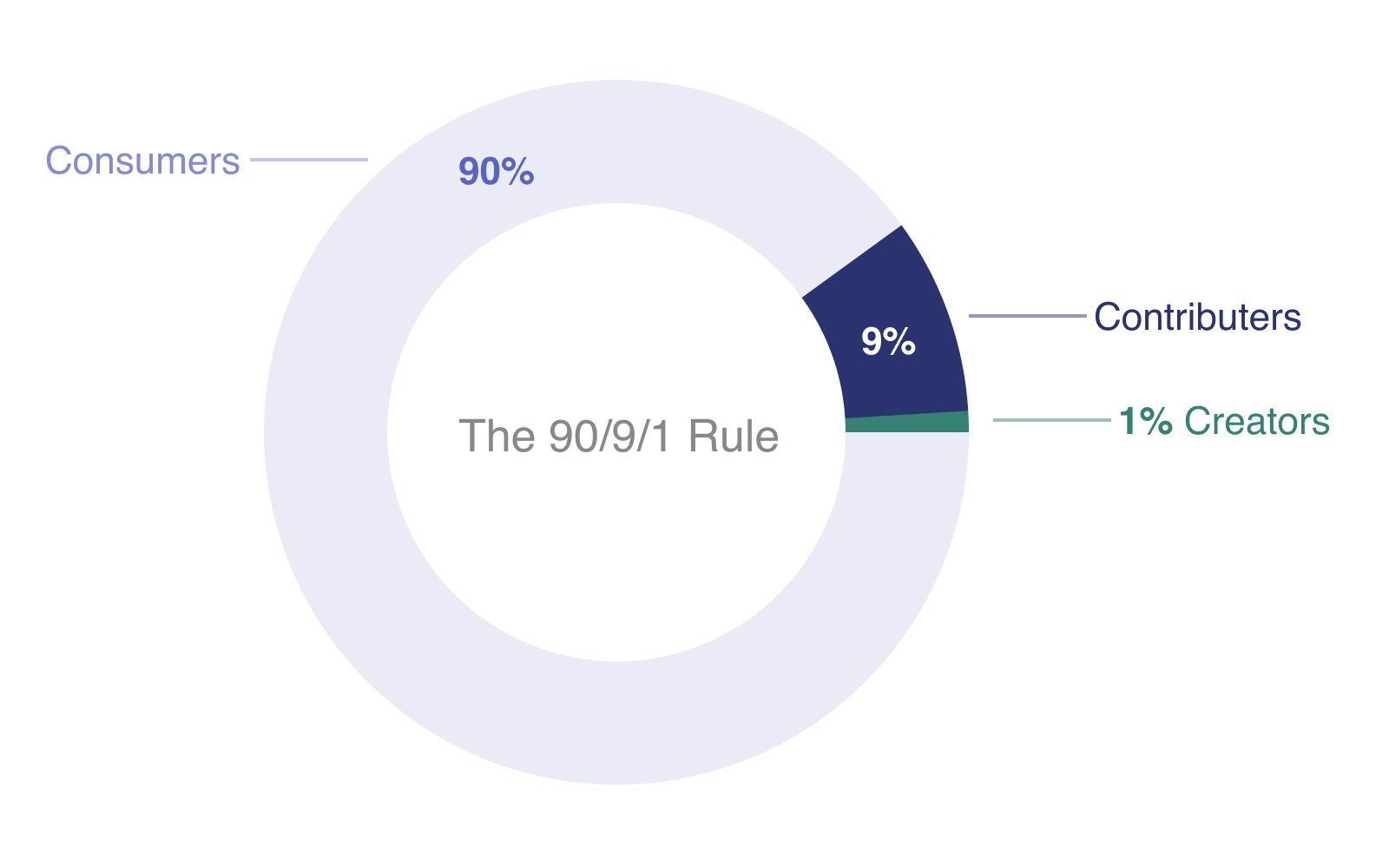7 Reasons Why You Need to Know the 90/9/1 Rule
What the Alumni Engagement Rule Means for You

This article explains an accepted rule of thumb in Silicon Valley that applies to all social media platforms used to engage with alumni such as Facebook, LinkedIn, Twitter, Instagram, and Pinterest. The 90/9/1 rule has important ramifications for alumni relations and development. A fundamental assumption of this article is that one of the purposes of alumni engagement is to increase giving.
Seminal academic research by Arkes and Blumer showed that people commit the sunk cost fallacy when they continue a behavior or endeavor as a result of previously invested resources (time, money or effort).
The methods, processes and software applications currently used by alumni relations and development are the result of decisions predicated on a particular set of assumptions. However, it is an axiom of any organization that past decisions need to be revisited when previous assumptions are no longer valid. It is undeniable that the environment facing universities now and for the foreseeable future is radically different from even six months ago.
It is clear that universities will need to rely even more on generous alumni to overcome their financial challenges. The way forward for universities is to rethink their online engagement strategy, tactics, metrics and software applications in order to effectively align alumni engagement with development, and increase giving.
There are two types of fundraising:
- Transactional (e.g. Phonathon) – high volume, low value, low touch
- Relationship (e.g. Major, Principal and Planned Gifts) – low volume, high value, high touch
The strategy, tactics, and metrics for both are very different. Your alumni engagement efforts need to reflect those differences and mirror your gifting pyramid.
Your university likely already uses social media to engage alumni. Perhaps, your university even tracks “Likes”, comments, and shares to discover which alumni are engaged and what their interests are. However, although these strategies may work on the surface level, they leave a lot of potential insights behind. Worse, they leave the majority of your alumni unengaged – and valuable information undiscovered.
The truth is, traditional social media doesn’t engage the vast majority of alumni. This lack of engagement isn’t unique to universities – most members of online communities don’t engage with the content they see and even fewer create content.
The 90/9/1 rule has been used to document online engagement behavior for years. It shows that:
- 90% CONSUME content passively,
- 9% CONTRIBUTE to content (like, comment, share), and
- 1% CREATE content.

Note that the vast majority of content is created by only a very small minority of users.
The 90/9/1 rule should not be surprising to anyone in advancement. It is well known that the vast majority of donation dollars are given by a small minority of alumni. In general, a minority of your users/donors/alumni contribute the majority of content/dollars/volunteer hours.
New research has shown the 90/9/1 rule to be an optimistic view of the situation. Furthermore, social networks for philanthropic causes have an even larger participation inequality, with 99.3% of users lurking without contributing and a mere 0.7% contributing content.
Why is this important for your alumni engagement strategy and what can be done to maximize engagement ROI?
There are 7 reasons why it is critical to understand the 90/9/1 Rule:
1. It Determines the Quantity of Cultivation Insights
For development to truly benefit from the time and money spent on alumni engagement, it needs to collect actionable insights from individual alumni. If you use Facebook or other alumni engagement applications your engagement ROI is almost certainly being limited by the 90/9/1 rule. Your Development Officers are not gaining insights from 90% (or more) of your users. Moreover, they also gain no insight from alumni who never visit your pages or applications.
The 9% provide at least some insights for your development officers, but universities have much more to gain from content that alumni create versus content they consume, or contribute to by liking. After all, for maximizing relationship fundraising results, the more insights about your prospects the better.
A simple “Like” doesn’t give a Development Officer anywhere near the same quantity of insights into an alum compared with content an alum directly creates – content that reflects their passions and values. These two forms of engagement don’t provide the same insights, and therefore they shouldn’t be treated the same way by your university.
This is amplified if the content is created as a response to a prompt specifically designed to elicit the alum’s fond memories of their alma mater, impactful college experiences, gratitude to a particular professor, and so forth. Purposeful engagement that proactively encourages content creation delivers the most actionable insights for qualification and cultivation.
2. It Impacts the Quality of Cultivation Insights
From development’s perspective, not all information that can be gathered from alumni engagement platforms is equally useful. A "Like" on a post can offer a hint as to what an alum may be interested in, but it doesn’t tell the full story.
Have you ever “Liked” a friend’s post, even though you didn’t actually read it? If you can’t be certain that the alum actually liked a post or if they just “Liked” it, then any assumption inferred from that engagement is suspect.
Moreover, the business model of social media platforms such as Facebook emphasizes quantity, not quality, of content. It’s easy to generate a lot of Likes by posting funny cat videos, for example. But knowing that an alum likes funny cat videos, or likes to read Time magazine is not relevant to why your alum cares about your university. Or, for non-alumni donors, it doesn’t identify what connects that alum to your university’s mission. The Like is not actionable.
That’s why the quality of insight gained from a “Like” cannot compare to the quality of insight gained from an alum’s created content.
3. To Improve Engagement ROI, You Must Measure Who is in the 90, 9, and 1
A university has multiple purposes for online engagement with its alumni. Keeping alumni informed about university news might be one of them. Helping recent grads with their career could be another. However, one of the most important purposes of alumni engagement is to help development achieve its goals. For Development Officers to do their jobs effectively they need actionable insights about specific alumni that they can use for cultivation.
As a university has multiple engagement purposes, it also needs engagement metrics that are designed with each purpose in mind. It might be meaningful to count "Likes” for posts that broadcast campus updates to all alumni. However, that is not an appropriate metric for a VP of Development. They need metrics that measure engagement against potential return on investment, not absolute reach.
Who is the target engagement audience for major gifts, principal gifts, or planned gifts? Knowing that 10,000 Millennials "Liked” a post on the university’s Facebook page is not as useful to development compared to knowing that 1,000 Baby Boomers prospects "Liked” a post. Alumni engagement is only useful to development if it reaches their prospects.
Measuring whether the university’s engagement efforts are reaching development’s high value prospects is just the starting point. The university needs to know where alumni fall on the 90/9/1 spectrum because that is what determines the quantity and quality of actionable insights for Development Officers.
4. Your Engagement ROI is Limited Unless You Shift Alumni From the 90 to the 9, to the 1
Your engagement strategy should not just be about getting more alumni to engage. It must actively aim to turn alumni from consumers (the 90%) into contributors (the 9%), and ultimately into creators (the 1%). This is necessary to maximize the quantity and quality of cultivation insights for Development Officers.
CueBack has several patent-pending features designed to specifically break the 90/9/1 Rule.
5. You Have to Break the Rule to Get Cultivation Insights from Completely Unengaged Alumni
CueBack’s Discovery Reports™ can uncover insights from prospects even if they are in the 90% category. Moreover, we can uncover insights about alumni even if they do not log into the application! Think about that. If a university has a Facebook page or third party alumni engagement application, but the alum never uses them, how can a Development Officer gain any insight about the alum? It’s not possible. But you can get those insights with CueBack.
CueBack is a next-generation alumni engagement application purpose-built to overcome this severe limitation. One of the ways CueBack does this is by leveraging the ‘cocktail party’ effect to collect insights, even if the alum never posts content themselves. The 90/9/1 rule doesn’t mean there’s no hope to get insights from unengaged alumni – you just have to be creative.
6. You Can’t Boil the Ocean – Understand Where to Focus Engagement Efforts
From a Development Officer’s perspective, data is not actionable for cultivation if it is not at the individual alum level. They care about the engagement of the 150 alumni in their portfolio, not that 5% of all alumni "Liked” a post.
When budgets are tight, it becomes increasingly important to demonstrate ROI for expenditures. Engage with all alumni, but smartly. It is an inefficient and unnecessary use of alumni relations' resources to create an engagement score for each alum. You only need to measure the engagement of your high value alumni.
If a goal of alumni engagement is to increase giving, then you only need to measure the engagement of:
- Existing major gift prospects,
- Alumni who may become major gift donors in the next 3-5 years, and
- Any alum who may be an influencer on either of these two groups.
Combined, this is a much more manageable number of alumni to focus on. The benefit of spending 80% of your engagement effort on the “20%” is that you can hyper-personalize content to them and provide a superior engagement experience. A targeted approach to alumni engagement is necessary for maximizing ROI.
7. Your Content and Engagement Strategy Must be Data-Driven
Mass social media broadcasts lack a personalized impact on alumni, and thus don’t make much of a difference in your university’s overall engagement. However, by focusing on gaining insights into individual alumni, your university can ensure that the right content is being seen by the right alumni. For a Development Officer, deeply understanding the interests of several high capacity alumni has much more value than gathering topical "Like" data from a larger pool of low capacity alumni.
For this reason, engagement content should be targeted according to the capacity of alumni, not only the volume of alumni. Providing relevant and meaningful content for alumni with a high capacity to donate will have the greatest impact on development ROI.
Conclusion
Personalization for all, but hyper-personalization for some. Go way beyond Likes and irrelevant interests to learn why your prospect should or does care about your university. Adopt an automated alumni engagement approach that leverages over a thousand pre-loaded prompts to proactively uncover insights that increase the results of your Development Officers.
This is not alumni engagement merely for keeping alumni connected and informed. That was yesterday. This is about the future. Choose to use alumni engagement that increases willingness to give.
Alumni engagement of the future is a force multiplier for your Development Officers. Use it to build lifelong deep and meaningful relationships with your current and future high-value prospects. And increase giving.
Stay ahead of the curve with CueBack
The world of advancement is changing. Don’t get left behind. Stay ahead of the curve with insights from forward thinkers in the industry who are paving the way for tomorrow’s advancement professional leaders.